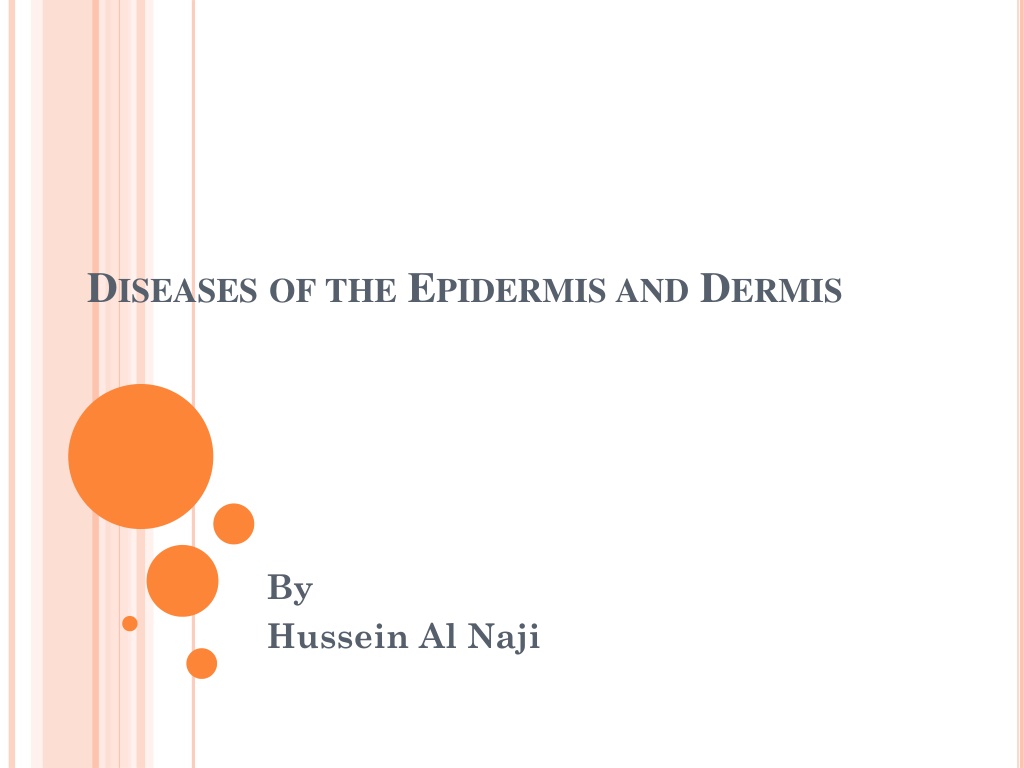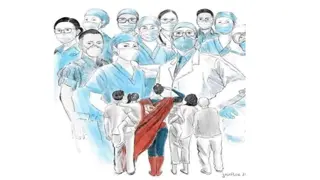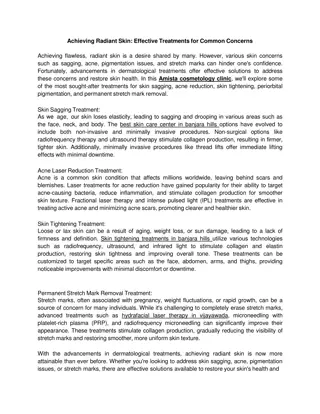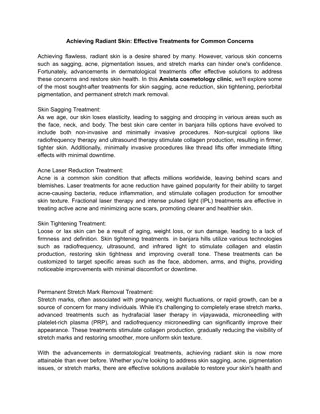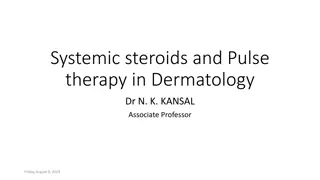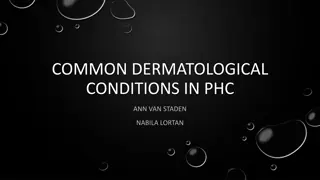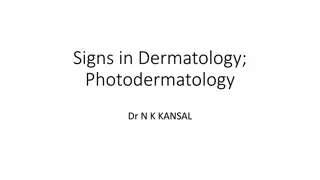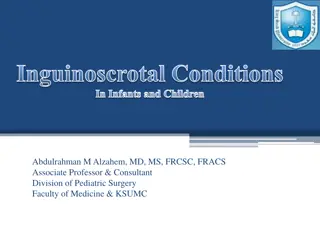Dermatological Conditions: Pityriasis and Hyperkeratosis Overview
Pityriasis is characterized by bran-like skin scales due to overproduction of keratinized cells, with primary and secondary forms and associated causal factors. Hyperkeratosis, on the other hand, results from excessive keratinization causing accumulation of epithelial cells on the skin, with localized and generalized causes identified, including mechanical stress, parasitism, and poisoning. Treatment approaches vary based on the underlying condition, emphasizing primary cause correction and supportive care with emollients and lotions.
Download Presentation

Please find below an Image/Link to download the presentation.
The content on the website is provided AS IS for your information and personal use only. It may not be sold, licensed, or shared on other websites without obtaining consent from the author. Download presentation by click this link. If you encounter any issues during the download, it is possible that the publisher has removed the file from their server.
E N D
Presentation Transcript
DISEASES OF THE EPIDERMIS AND DERMIS By Hussein Al Naji
PITYRIASIS Pityriasis scales are accumulations of keratinized epithelial cells, sometimes softened &made greasy by the exudation of serum or sebum. Primary pityriasis is characterized by excessive bran-like scales on the skin and is caused by overproduction of keratinized epithelial cells. The etiology is uncertain. The diagnosis is based on clinical presentation and can be supported by further diagnostic testing ruling out other differential diagnoses. causative or predisposing factors are as follows: 1. HypovitaminosisA 2. Nutritional deficiency of B vitamins. 3. Poisoning by iodine
Secondary pityriasis is characterized by excessive desquamation of epithelial cells and usually associated with the following: 1. Scratching in flea, louse, and mange infestations 2. Keratolytic infection (e.g., with ringworm fungus). Primary pityriasis scales are superficial, accumulate where the coat is long, and are usually associated with a dry, lusterless coat. Itching or other skin lesions are not features. Secondary pityriasis is usually accompanied by the lesions of the primary disease. Pityriasis is identified by the absence of parasites and fungi in skin scrapings.
DIFFERENTIAL DIAGNOSIS 1. Hyperkeratosis 2. Parakeratosis 3. Ringworm TREATMENT Primary treatment requires correction of the primary cause. Supportive treatment commences with a thorough washing, followed by alternating applications of a bland emollient ointment and an alcoholic lotion. Salicylic acid is frequently incorporated into a lotion or ointment with a lanolin base.
HYPERKERATOSIS Epithelial cells accumulate on the skin as a result of excessive keratinization of epithelial cells and intercellular bridges, interference layer of the epidermis, and hypertrophy of the stratum corneum. Local hyperkeratosis may be caused by the following: 1. Mechanical stress on pressure points (e.g., elbows, hocks, or brisket) when animals lie habitually on hard surfaces 2. Mechanical and/or chemical stress (e.g., teat-end keratosis of dairy cows that can be caused by improper milking machine settings, overmilking, improper use of teat sanitizers or cold weather) 3. Parasitism (hyperkeratotic form of sarcoptes of small ruminants)
Generalized hyperkeratosis may be caused by the following: 1. Poisoning with highly chlorinated naphthalene compounds 2. Chronic arsenic poisoning 3. Inherited congenital ichthyosis 4. Infection with a fungus, was recently associated with generalized hyperkeratosis in a calf and a goat kid.
The skin is dry, scaly, thicker than normal, usually corrugated, hairless, and fissured in a gridlike pattern. Secondary infection of deep fissures may occur if the area is continually wet. Confirmation of the diagnosis is by the demonstration of the characteristically thickened stratum corneum in a biopsy section, which also serves to differentiate the condition from parakeratosis, inherited ichthyosis Congenital and Inherited Skin Defects ). Primary treatment depends on correction of the cause. Supportive treatment is by the application of a keratolytic agent (e.g., salicylic acid ointment).
PARAKERATOSIS Parakeratosis, a skin condition characterized by incomplete keratinization of epithelial cells, can have various causes: Caused by 1. nonspecific chronic inflammation of cellular epidermis 2. Associated with dietary deficiency of zinc Part of an inherited disease The initial lesion comprises edema of the prickle cell layer, dilatation of the intercellular lymphatics, and leukocyte infiltration. Imperfect keratinization of epithelial cells at the granular layer of the epidermis follows, and the horn cells produced are sticky and soft, retain their nuclei, and stick together to form large masses, which stay fixed to the underlying tissues or are shed as thick scales.
Initially the skin is reddened, followed by thickening and gray discoloration. Large, soft scales accumulate, are often held in place by hairs, and usually crack and fissure; their removal leaves a raw, red surface. Hyperkeratosis scales are thin and dry and accompany an intact, normal skin. The diagnosis is made based on the clinical presentation and can be confirmed by the identification of imperfect keratinization in a histopathological examination of a biopsy or a skin section at necropsy.
DIFFERENTIAL DIAGNOSIS 1. Hyperkeratosis 2. Ringworm 3. Sarcoptic mange 4. Inherited ichthyosis 5. Inherited parakeratosis of calves 6. Inherited epidermal dysplasia.
TREATMENT Primary treatment requires correction of any nutritional deficiency (specifically, correcting zinc and preventing excessive dietary calcium content). Supportive treatment includes 1. Removal of the crusts by the use of keratolytic agent (e.g., salicylic acid ointment) or by vigorous scrubbing with soapy water, followed by application of an astringent (e.g., white lotion paste), which must be applied frequently and for some time after the lesions have disappeared.
IMPETIGO Impetigo is a superficial eruption of thinwalled, small vesicles, surrounded by a zone of erythema, that develop into pustules, then rupture to form scabs. In humans, impetigo is specifically a streptococcal infection, but lesions are often invaded secondarily by staphylococci. In animals the main organism found is usually a staphylococcus. The causative organism appears to gain entry through minor abrasions, with spread resulting from rupture of lesions causing contamination of surrounding skin and the development of secondary lesions.
Two specific examples of impetigo in large animals are as follows: Udder impetigo (udder acne) of cows Contagious impetigo, also known as exudative epidermitis (see also Udder Impetigo ) or greasy pig disease, Confirmation of the diagnosis is by isolation of staphylococci from vesicular fluid. DIFFERENTIAL DIAGNOSIS 1. Cowpox/buffalopox, in which the lesions occur almost exclusively on the teats and pass through the characteristic stages of pox 2. Pseudocowpox, lesions restricted in occurrence to the teats 3. Ringworm.
TREATMENT Primary treatment with antibiotic topically is usually all that is required because individual lesions heal so rapidly. Supportive treatment is aimed at preventing the occurrence of secondary lesions and spread of the disease to other animals. Twice-daily bathing with an efficient germicidal skin wash is usually adequate.
URTICARIA Urticaria (hives) is a skin condition characterized by development of topical dermal edema becoming apparent as cutaneous wheals. Horses are the most commonly affected species. In acute cases hives appear suddenly and regress within hours. chronic cases are characterized by the continuous recurrence of new wheals on the skin for days or even months. Urticaria can occur as localized allergic reaction only affecting parts of the skin or as part of a more severe systemic a allergic reaction.
Primary urticaria can be caused by the following: 1. Insect stings 2. Contact with stinging plants 3. Ingestion of unusual food, with the allergen, usually a protein 4. Occasionally an unusual feed item (e.g., garlic to a horse). 5. Administration of a particular drug (e.g., penicillin, streptomycin, possibly guaifenesin or other anesthetic agent) 6. Allergic reaction in cattle following vaccination for foot-and- mouth disease. 7. Death of warble fly larvae in tissue
8- Milk allergy when Jersey cows are dried off. 9- Transfusion reaction. 10-Cutaneous vasculitis (purpurea hemorrhagica). 11-Local skin trauma (dermatographism). 12- Temperature induced (heat, cold, sunlight) 13. Infection parasitic, bacterial, fungal, viral. Secondary urticaria occurs as part of a syndrome, such as Respiratory tract infections in horses, including strangles and the upper respiratory tract viral infections.
PATHOGENESIS Degranulation of mast cells liberating chemical mediators of inflammation that result in the subsequent development of dermal edema is the presumed cause for the development of urticaria. A primary dilatation of capillaries causes cutaneous erythema. Exudation from the damaged capillary walls causes local edema in the dermis, and a wheal develops.
CLINICAL FINDINGS 1. Wheals, mostly circular, well-delineated, steep-sided, easily visible elevations in the skin, appear very rapidly and often in large numbers, commencing usually on the neck but being most numerous on the body. 2. They vary from 0.5 to 5 cm in diameter, with a flat top, and are tense to the touch. There is often no itching, except with plant or insect stings, and no discontinuity of the epithelial surface, exudation, or weeping. 3. Pallor of the skin in wheals can be observed only in unpigmented. 4. Other allergic phenomena, including diarrhea and slight fever, may accompany the eruption.
DIFFERENTIAL DIAGNOSIS Urticaria is manifested by a suddenappearance of a crop of cutaneous weals, sometimes accompanied by restlessness, mostly in horses, occasionally in cattle. Identification of the etiology is also helpful in diagnosis but is often difficult, depending on a carefully taken history and examination of the environment. The differential diagnosis list is limited to angioedema, but in urticaria the lesions can be palpated in the skin itself.Angioedema
TREATMENT Acute anaphylaxis with urticaria in horses: 1. Epinephrine: 3 to 5 mL/450 kg of a 1 : 1000 solution IM or SC (can be combined with steroids). Acute urticaria in horses: 1. Dexamethasone soluble 0.01 to 0.1 mg/kg IV or IM q24 h for 3 to 7 days.
Chronic or recurrent urticaria: 1. Prednisolone 0.25 to 1.0 mg/kg IV or PO q24 h. Reduce to 0.2 to 0.5 mg/kg q48 h. 2. Dexamethasone 0.01 to 0.02 mg/kg POq48-72 h . Further reduce dose until the lowest dose keeping the animal free of signs is determined. 3. Hydroxyzine hydrochloride 0.5 to 1.0 mg/kg IM or PO q8 h. 4. Diphenhydramine hydrochloride 0.7 to 1 mg/kg q12 h. 5. Chlorpheniramine 0.25 to 0.5 mg/kg q12 h
